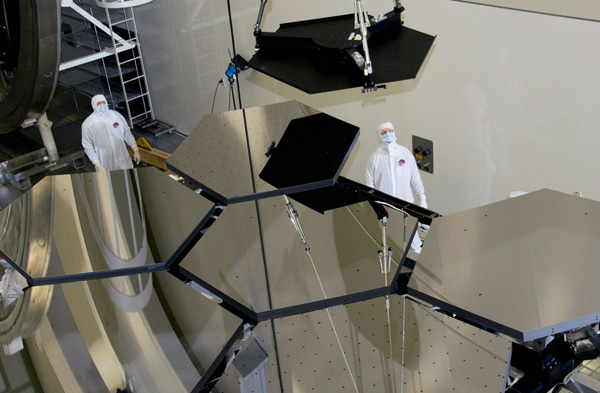NASA Woes: Hubble's Replacement Behind Schedule; Shuttle Cracks Found
Posted on Categories Discover Magazine

Hubble’s successor will be late, and over-budget. So concluded a NASA panel this week that investigate the James Webb Space Telescope, NASA’s next big thing, intended to survey the skies in infrared light with its 18-segment mirror. The word all along has been that James Webb would launch in 2014 at a cost of $5 billion, but the independent review (pdf) concluded that the earliest possible launch would be September 2015, and at a cost of more like $6.5 billion.
The report raised fear that other projects would be hurt. “This is NASA’s Hurricane Katrina,” said Alan P. Boss, who leads the subcommittee that advises NASA’s astrophysics program. The telescope, he said, “will leave nothing but devastation in the astrophysics division budget.” [The New York Times]
John R. Casani, who managed missions like Cassini and Voyager that are the picture of NASA success, led the panel. The technical side of the Webb telescope isn’t the problem, the report found–the management side is. The report faulted the management team for failing to make realistic estimates of the project’s costs and timetable, and further criticized NASA headquarters for not calling the managers on their impractical assessments.
Even to meet the delayed launch date of 2015, Casani says, NASA would need to scrounge up an additional $200 million next year and in 2012. Christopher J. Scolese, NASA associate administrator, said that feat of financial juggle was unlikely. But Charles Bolden, the head of NASA, said he would act on the recommendation to shake up the project’s management.
“No one is more concerned about the situation we find ourselves in than I am, and that is why I am reorganizing the JWST Project at Headquarters and the Goddard Space Flight Center, and assigning a new senior manager at Headquarters to lead this important effort,” Bolden said in the statement. [MSNBC]
All this comes just weeks after Nature called JWST “the telescope that ate astronomy” and wondered whether the telescope’s huge scale and budget would squeeze out other projects, leaving science too dependent on the big machine.
It hasn’t been the best month for NASA, anyway. A planned space shuttle Discovery launch was delayed last week after inspectors found a fuel leak. Subsequent looks at Discovery have now turned up cracks in the external fuel tank that could indefinitely delay the mission.
The two cracks – each 9 inches long – were found on the exterior of the aluminum tank, beneath a larger crack in the insulating foam that covers the 15-story tank. The cracks are in an area that holds instruments, not fuel. NASA spokesman Allard Beutel said engineers believe the tank can be repaired at the launch pad, although it’s never been tried before. It’s unclear, though, whether the work can be done in time to meet a Nov. 30 launch attempt. [AP]
Lastly, a bit of good news: The ever-productive Cassini probe, which surprised its operators by going into safe mode on November 2 in the midst of its grand tour of the Saturn system, should be fully operational again before Thanksgiving.
Related Content:
80beats: Astronauts Bid a Fond Farewell to the Hubble
80beats: A Hot Piece of Hardware: NASA’s New Orbiter Will Map the Entire Sky in Infrared
Discoblog: World Science Festival: The 4 Ways to Find E.T., aided by JWST
Bad Astronomy: The Making of JWST’s Sunshade
Image: NASA/MSFC/Emmett Givens